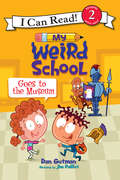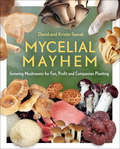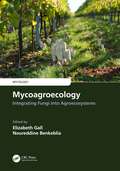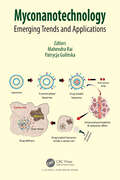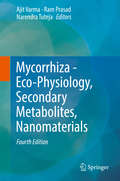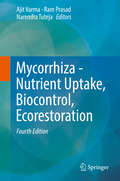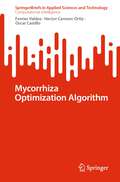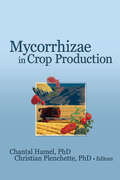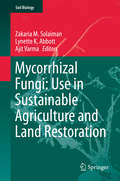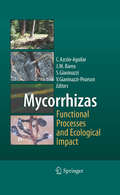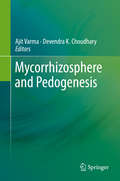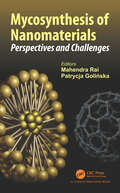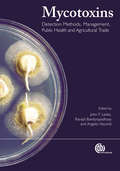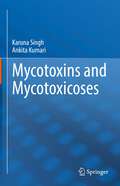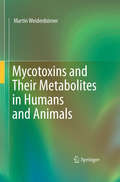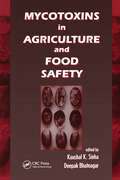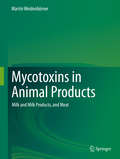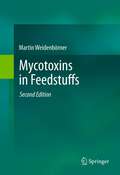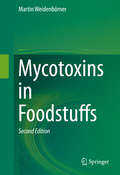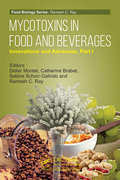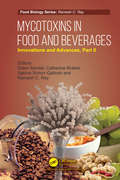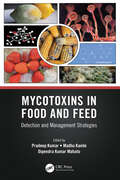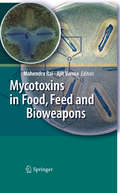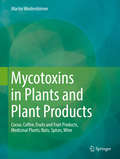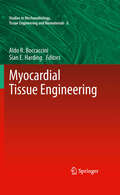- Table View
- List View
My Weird School Goes to the Museum (I Can Read Level 2)
by Dan GutmanThis fun Level Two I Can Read book, geared toward kids who read on their own but still need a little help, is based on Dan Gutman’s My Weird School series, which has sold more than 12 million books!A.J. and Andrea are taking a class trip to the museum! Their museum guide has been warned that one of them might misbehave. But who will it be? Join A.J. and Andrea from Ella Mentry School on this hilarious field trip as they show young readers why they attend the weirdest—and most fun!—school around.
Mycelial Mayhem: Growing Mushrooms for Fun, Profit and Companion Planting
by David Sewak Kristin Sewak“A comprehensive and personal tome on the production, business, promotion, and problem solving for the independent mushroom grower.” —Taylor Lockwood, renowned mushroom expert & photographerMost supermarket mushrooms are bland and boring; products of an industrial process which typically relies on expensive equipment and harmful pesticides. Many people would like to add more flavorful and diverse fungi to their diets, but lack the knowledge or confidence to gather or grow their own. Do-it-yourself cultivation is a fun, exciting way to incorporate a variety of mushrooms into a sustainable lifestyle.Mycelial Mayhem is a straightforward, no-nonsense resource for the aspiring mushroom grower. This practical guide cuts through much of the confusion surrounding methods and techniques, helping the hobbyist or farmer to:Select regionally appropriate species for the home garden, farm-scale production, or an edible landscapePractice sustainable, environmentally friendly cultivation techniques, such as companion planting, to combat common garden pests and diseasesChoose a successful, proven business approach to maximize profit and minimize frustrationMany people find that DIY mushroom cultivation is not nearly as complicated as they expect, but a knowledgeable and experienced mentor is crucial to success. Whether your goal is to harvest homegrown gourmet mushrooms for your table, supplement your income by selling to friends and neighbors, or start a full-fledged niche business, Mycelial Mayhem is packed with the advice and resources you need to succeed with this rewarding and valuable crop.“After reading Mycelial Mayhem’s approachable primer to this age-old art I’m ready to invite the mysterious and captivating kingdom of fungi right into my own home.” —Langdon Cook, author of The Mushroom Hunters
Mycoagroecology: Integrating Fungi into Agroecosystems (Mycology #33)
by Noureddine Benkeblia Elizabeth “Izzie” GallDuring the 20th century, agriculture underwent many unsustainable changes for the sake of greater food production. Today, the effects of climate change are becoming ever more apparent and the global population continues to grow, placing additional pressures on agricultural systems. For this reason, it is vital to turn international agriculture towards a sustainable future capable of providing healthy, bountiful foods by using methods that preserve and reconstruct the balance of natural ecosystems. Fungi are an underappreciated, underutilized group of organisms with massive potential to aid in the production of healthy food and other products while also increasing the sustainability of agricultural systems. Mycoagroecology: Integrating Fungi into Agroecosystems lays the foundations for integrated fungal-agricultural understanding and management, the proposed practice of “mycoagroecology”. Suitable for students and professionals of multiple disciplines, this text includes nine introductory chapters that create a firm foundation in ecosystem functioning, evolution and population dynamics, fungal biology, principles of crop breeding and pest management, basic economics of agriculture, and the history of agricultural development during the 20th century. The latter half of the text is application-oriented, integrating the knowledge from the introductory chapters to help readers understand more deeply the various roles of fungi in natural and agricultural systems: PARTNERS: This text explores known benefits of wild plant-fungal mutualisms, and how to foster and maintain these relationships in a productive agricultural setting. PESTS AND PEST CONTROL AGENTS: This text acknowledges the historical and continuing role of agriculturally significant fungal pathogens, surveying modern chemical, biotechnological, and cultural methods of controlling them and other pests. However, this book also emphasizes the strong potential of beneficial fungi to biologically control fungal, insect, and other pests. PRODUCTS: This text covers not just isolated production of mushrooms on specialized farms but also the potential for co-cropping mushrooms in existing plant-based farms, making farm systems more self-sustaining while adding valuable and nutritious new products. An extensive chapter is also devoted to the many historical and forward-facing uses of fungi in food preservation and processing.
Myconanotechnology: Emerging Trends and Applications
by Mahendra Rai Patrycja GolińskaMyconanotechnology is a highly interdisciplinary science emerging at a fast pace and has garnered the attention of nanotechnologists, mycologists, biomedical experts, and agriculture scientists, among others. For the last decade, there has been tremendous progress in this field owing to its wider and more effective applications. In this book, the authors have attempted to discuss different evolving trends in medicine, food, agriculture, veterinary, environment, and textiles. Globally contributed by eminent authors and experts, the present book contains valuable chapters on the diverse aspects of Myconanotechnology and thus would be essential reading for academicians. This book will cater to the need of postgraduate and research students in fungal biology, microbiology, chemistry, nanotechnology, biotechnology, and pharmacology.
Mycorrhiza - Eco-Physiology, Secondary Metabolites, Nanomaterials
by Ajit Varma Ram Prasad Narendra TutejaThis is the fourth updated and revised edition of a well-received book that emphasises on fungal diversity, plant productivity and sustainability. It contains new chapters written by leading experts in the field. This book is an up-to-date overview of current progress in mycorrhiza and association with plant productivity and environmental sustainability. The result is a must hands-on guide, ideally suited for agri-biotechnology, soil biology, fungal biology including mycorrhiza and stress management, academia and researchers. The topic of this book is particularly relevant to researchers involved in mycorrhiza, especially to food security and environmental protection. Mycorrhizas are symbioses between fungi and the roots of higher plants. As more than 90% of all known species of plants have the potential to form mycorrhizal associations, the productivity and species composition and the diversity of natural ecosystems are frequently dependent upon the presence and activity of mycorrhizas. The biotechnological application of mycorrhizas is expected to promote the production of food while maintaining ecologically and economically sustainable production systems.
Mycorrhiza - Nutrient Uptake, Biocontrol, Ecorestoration
by Narendra Tuteja Ajit Varma Ram PrasadThis is the fourth updated and revised edition of a well-received book that emphasises on fungal diversity, plant productivity and sustainability. It contains new chapters written by leading experts in the field. This book is an up-to-date overview of current progress in mycorrhiza and association with plant productivity and environmental sustainability. The result is a must hands-on guide, ideally suited for agri-biotechnology, soil biology, fungal biology including mycorrrhiza and stress management, academia and researchers. The topic of this book is particularly relevant to researchers involved in mycorrhiza, especially to food security, plant microbe interaction and environmental protection. Mycorrhizas are symbioses between fungi and the roots of higher plants. As more than 90% of all known species of plants have the potential to form mycorrhizal associations, the productivity and species composition and the diversity of natural ecosystems are frequently dependent upon the presence and activity of mycorrhizas. The biotechnological application of mycorrhizas is expected to promote the production of food while maintaining ecologically and economically sustainable production systems.
Mycorrhiza Optimization Algorithm (SpringerBriefs in Applied Sciences and Technology)
by Fevrier Valdez Hector Carreon-Ortiz Oscar CastilloThis book provides two new optimization algorithms to address real optimization problems. Optimization is a fundamental concept in engineering and science, and its applications are needed in many fields. From designing products and systems to developing algorithms and models, optimization plays a critical role in achieving efficient and effective solutions to complex problems. Optimization algorithms inspired by nature have proven effective in solving a wide range of problems, including those in engineering, finance, and machine learning. These algorithms are often used when traditional optimization techniques are impractical due to the size or complexity of the problem. In this book, we are presenting two new optimization algorithms inspired by plant roots and the Mycorrhiza Network. The first algorithm is called the Continuous Mycorrhiza Optimization Algorithm (CMOA), which was proposed based on the model of the Continuous Lotka-Volterra System Equations. The second algorithm is called the Discrete Mycorrhiza Optimization Algorithm (DMOA), which design based on the model of Discrete Lotka-Volterra System Equations. By mastering the proposed algorithms, the readers able to develop innovative solutions that improve efficiency, reduce costs, and improve performance in the corresponding field of work.
Mycorrhizae in Crop Production
by Chantal Hamel Christian PlenchetteDesign cropping practices that make the most of the contribution of AM fungi Mycorrhizae in Crop Production is a comprehensive guide to the use of arbuscular mycorrhizal fungi (AMF) in developing sustainable cropping systems. This unique book examines how AMF benefit crop plants in both greenhouse and field crop production. It’s als
Mycorrhizal Fungi: Use in Sustainable Agriculture and Land Restoration
by Zakaria M. Solaiman Lynette K. Abbott Ajit VarmaThis volume explores the various functions and potential applications of mycorrhizas, including topics such as the dynamics of root colonization, soil carbon sequestration and the function of mycorrhizas in extreme environments. Some contributions focus on the use of arbuscular mycorrhizal fungi in various crop production processes, including soil management practices, their use as biofertilizers and in relation to medicinal plants. Other chapters elucidate the role of arbuscular mycorrhizal fungi in the alleviation of plant water stress and of heavy metal toxicity, in the remediation of saline soils, in mining-site rehabilitation and in the reforestation of degraded tropical forests. In addition to their impact in ecosystems, the economic benefits of applying arbuscular mycorrhizal fungi are discussed. A final chapter describes recent advances in the cultivation of edible mycorrhizal mushrooms.
Mycorrhizas - Functional Processes and Ecological Impact
by Silvio Gianinazzi Jose Miguel Barea Vivienne Gianinazzi-Pearson Concepción Azcón-AguilarMycorrhizal symbioses are central to the multitrophic interactions that impact plant productivity, competitiveness and survival. This book integrates present-day knowledge from well-known research groups on some of the topics which are at the forefront of mycorrhizal research. Topics include the cell programmes that drive mycorrhiza formation and function, the processes sustaining symbiotic mutualism, stress response mechanisms in mycorrhizal symbionts, and the diversity and ecological impacts of mycorrhizal systems. The efficient management of mycorrhizal systems has the potential to support the sustainable production of quality foods while ensuring environmental quality for future generations.
Mycorrhizosphere and Pedogenesis
by Ajit Varma Devendra K. ChoudharyThe present book highlights importance of mycorrhiza in soil genesis wherein it reflects mycorrhizal occurrence and diversity, various tools to characterize them and its impact on soil formation/health together with crop productivity. The edited compendium provides glimpses on the mycorrhizal fungi and their prominent role in nutrient transfer into host plants, and presenting view on application of mycorrhiza for crop biofortification. It focuses on the mechanisms involve in weathering process employed by mycorrhiza with highlighting the current and advanced molecular approaches for studying mycorrhizal diversity. Further, book emphasizes following aspects in details: significance of AMF in phytoremediation of hydrocarbon contaminated sites, the role of mycorrhiza in soil genesis using scientometric approach, the concept of mycorrhizosphere, xenobiotic metabolism, molecular approaches for detoxifying the organic xenobiotics and the role of mycorrhizosphere in stabilizing the environment in an eco-friendly way. In addition, the book will be benign to researchers that involved in mycorrhiza characterization especially by deploying metagenomics/PCR based and non PCR based molecular techniques that may be utilized to study the microbial diversity and structure within the mycorrhizosphere.
Mycosynthesis of Nanomaterials: Perspectives and Challenges
by Mahendra Rai Patrycja GolińskaMycosynthesis of Nanomaterials: Perspectives and challenges focus on the use of diverse groups of fungi for the synthesis of inorganic (metal and metalloid) and organic nanoparticles. Such synthesis is eco-friendly, economically viable, and can be carried out at ambient temperature without the use of high temperature, pressure or toxic chemicals. It also describes different techniques used for the characterization of the nanoparticles and various hypotheses put forward to elucidate the mechanistic aspect of the synthesis by fungi. There is a worldwide representation of eminent contributors including the US, Europe, Canada, Russia, India, Korea, Egypt, Brazil, Mexico, Colombia, Iran, and Sri Lanka. The book is interdisciplinary and essential reading for academicians.
Mycotoxins: Detection Methods, Management, Public Health and Agricultural Trade
by J. Leslie Ramananda Bandyopadhyay A. ViscontiMycotoxins are produced worldwide by several fungi on a wide range of agricultural commodities and are closely related to human and animal food chains. Examining mycotoxins and their impact from a public health viewpoint, this book provides an overview and introduction to the subject and examines the health, trade and legislation issues involved. Management of mycotoxins is discussed in detail as well as the global problems caused by mycotoxins.
Mycotoxins and Mycotoxicoses
by Karuna Singh Ankita KumariThis book presents a comprehensive view on mycotoxins of agricultural as well as non-agricultural environments and their health effects in humans and animals. Mycotoxins have immunosuppressive effects; but some of them can cause cancers, mutagenicity, neurotoxicity, liver and kidney damage, birth defects, DNA damage and respiratory disorders. The problem of mycotoxins is long-lasting and their direct or indirect exposures to humans and animals must be further discussed. The first chapter will cover the historical perspective of mycotoxins along with timeline while the second one will provide overview including classification of mycotoxins and mycotoxicoses. The comprehensive information/ literature on traditional, emerging and mushroom mycotoxins will be given in chapters 3, 4 and 5 respectively. Chapter 6 will deal with mycotoxins co-occurrence poisoning whereas new and masked mycotoxins will be described in chapter 7. The important aspects of mycotoxin studies like extraction, characterization and analysis and management strategies will be summarized in 8 and 9 chapters. The last chapter of the book will cover the recent developments in toxicokinetic studies of mycotoxins. The book will have the most up-to-date information and recent discoveries to deliver accurate data and to illustrate essential points to a wide range of readers including mycologists, clinicians, agricultural scientists, chemists, veterinarians, environmentalists and food scientists.
Mycotoxins and Their Metabolites in Humans and Animals
by Martin WeidenbörnerA mycotoxin is a toxin produced by a fungus under special conditions of moisture and temperature. These fungi are aerobic and microscopic and, moreover, may colonize many kinds of food from the field to the table. Mycotoxins are not only a spoilage issue for food, but in high doses can be a serious health threat for humans. The book will be similar to Weidenborner's previous two books - "Mycotoxins in Feedstuffs" and "Mycotoxins in Foodstuffs" - in that it will be a review of the literature to create a comprehensive reference for mycotoxin levels. It will be his third (and last) book on the topic, this time focusing on the incidence of a mycotoxin in humans and/or animals (natural or artificial incidence). Each entry will include contamination, concentration rate, mean concentration of organs (humans and animals) with a mycotoxin, as well as sample constitution (where possible) and country of origin of the sample.
Mycotoxins in Agriculture and Food Safety (Books in Soils, Plants, and the Environment)
by Kaushal K. Shinha Deepak BhatnagarDescribes a range of mycotoxins occurring as contaminants in agricultural crops and animal products, and details the implementation of food safety regulations via governmental and international agencies. The book charts the progress made in mycotoxicology since the early 1990s. It also profiles recent advances in mycotoxin analysis methods.
Mycotoxins in Animal Products: Milk and Milk Products, and Meat
by Martin WeidenbörnerThis book is one of three volumes expanding upon content found in Mycotoxins in Foodstuffs, Second Edition, and focuses on milk and milk products, and meat. Foodstuffs of plant origin that play only a minor role in mycotoxin contamination, such as asparagus, are also covered.Mycotoxins in Animal Products - Milk and Milk Products, and Meat comprises:More than 100 new publications and 300 publications in allSingle chapter overview with all mycotoxins and each foodstuff that is contaminatedCoverage of "co-contamination," showing the co-occurrence of mycotoxins in a foodstuff, where possibleCoverage of "further contamination,“ describing further foodstuffs with their mycotoxins documented, where possibleList of articles dealing with conventionally and organically produced foodstuffs and their mycotoxin contamination
Mycotoxins in Feedstuffs,. 2nd Edition
by Martin WeidenbörnerMycotoxins are substances produced from fungal secondary metabolic processes. They impair animal health, thereby causing great economic losses of livestock through disease. Livestock come into contact with mycotoxins through contaminated feedstuff. Feedstuff is any of the constituent nutrients of an animal ration. The plants used in feed, such as grains, oil seeds, nuts, and root crops, are susceptible to mycotoxin contamination. Mycotoxins in Feedstuffs lists (in the style of a dictionary) feeds which have been reported to have been contaminated with mycotoxins, including data on the degree of contamination, the concentration of the toxins, and the country of origin and/or detection of the contaminated feed. This second edition will feature: - More than 180 new publications concerning mycotoxins in feedstuffs. - A more efficient organization of the content, making the book easier to use in daily practice. - A single-chapter overview of mycotoxins in the corresponding feedstuffs.
Mycotoxins in Feedstuffs, 2nd Edition
by Martin WeidenbörnerMycotoxins are substances produced from fungal secondary metabolic processes. They impair animal health, thereby causing great economic losses of livestock through disease. Livestock come into contact with mycotoxins through contaminated feedstuff. Feedstuff is any of the constituent nutrients of an animal ration. The plants used in feed, such as grains, oil seeds, nuts, and root crops, are susceptible to mycotoxin contamination. Mycotoxins in Feedstuffs lists (in the style of a dictionary) feeds which have been reported to have been contaminated with mycotoxins, including data on the degree of contamination, the concentration of the toxins, and the country of origin and/or detection of the contaminated feed. This second edition will feature: - More than 180 new publications concerning mycotoxins in feedstuffs. - A more efficient organization of the content, making the book easier to use in daily practice. - A single-chapter overview of mycotoxins in the corresponding feedstuffs.
Mycotoxins in Food and Beverages: Innovations and Advances Part I (Food Biology Series)
by Didier Montet, Catherine Brabet, Sabine Schorr-Galindo and Ramesh C. RayMycotoxins are secondary metabolites produced by fungi in a wide range of foods (cereals, peanut, tree nuts, dried fruits, coffee, cocoa, grapes, spices…) both in the field and after harvest, particularly during storage. They can also be found in processed foods of plant origin, or by transfer, in food products of animal (milk, eggs, meat and offal). Mycotoxins are of major concern since they can cause acute or chronic intoxications in both humans and animals which are sometimes fatal. Many countries, particularly in Europe, have set maximum acceptable levels for mycotoxins in food and feed. The book reviews the latest literature and innovations on important aspects of mycotoxins, e.g. mycotoxin producing fungi and the related ecosystems, mycotoxin occurrence, toxicity, analysis and management. Quantitative estimations of impacts of climate change on mycotoxin occurrence have been made recently, using predictive modelling. There is also a growing interest in the occurrence and toxicity of multiple mycotoxins in food and feed, including emerging or modified forms of mycotoxins. Innovative tools were also developed to detect and quantify toxinogenic fungi and their toxins. In order to reduce the use of chemicals that are harmful to the environment and health of consumers, alternative methods of prevention and decontamination of mycotoxins were tested in pre- and post-harvest, using microorganisms, natural substances or radiation treatments.
Mycotoxins in Food and Beverages: Innovations and Advances, Part II (Food Biology Series)
by Didier Montet; Catherine Brabet; Sabine Schorr-Galindo; Ramesh C. RayMycotoxins are secondary metabolites produced by fungi in a wide range of foods (cereals, peanut, tree nuts, dried fruits, coffee, cocoa, grapes, spices…) both in the field and after harvest, particularly during storage. They can also be found in processed foods of plant origin, or by transfer, in food products of animal (milk, eggs, meat and offal). Mycotoxins are of major concern since they can cause acute or chronic intoxications in both humans and animals which are sometimes fatal. Many countries, particularly in Europe, have set maximum acceptable levels for mycotoxins in food and feed. The book reviews the latest literature and innovations on important aspects of mycotoxins, e.g. mycotoxin producing fungi and the related ecosystems, mycotoxin occurrence, toxicity, analysis and management. Quantitative estimation of impacts of climate change on mycotoxin occurrence have been made recently, using predictive modelling. There is also a growing interest in studying the occurrence and toxicity of multiple mycotoxins in food and feed, including emerging or modified forms of mycotoxins. Innovative tools have also developed to detect and quantify toxinogenic fungi and their toxins. In order to reduce the use of chemicals that are harmful to the environment and health of consumers, alternative methods of prevention and decontamination of mycotoxins were tested in pre- and post-harvest, using microorganisms, natural substances or radiation treatments.
Mycotoxins in Food and Feed: Detection and Management Strategies
by Pradeep Kumar Madhu Kamle Dipendra Kumar MahatoMycotoxins represent an assorted range of secondary fungal metabolites that extensively occur in numerous food and feed ingredients at any stage during pre- and post-harvest conditions. Mycotoxin contamination in food and feed cause acute and chronic mycotoxicosis, including teratogenic, carcinogenic, oestrogenic, neurotoxic, and immunosuppressive effects and several others health issues. Mycotoxins in Food and Feed presents an overview of all the major mycotoxins, sources of production, chemistry and biosynthesis, occurrence in food and feed, effect on agriculture, effect on human health, detection technique, masked mycotoxins, and management and control strategies. Key Features Provides broad coverage of mycotoxins and their effects on food and feed Includes comprehensive information of occurrence, chemistry, detections methods and management strategies for each toxin Discusses the recent development in detection technologies for major mycotoxins Explores agricultural practices and post-harvest management strategies for managing mycotoxin infestations
Mycotoxins in Food, Feed and Bioweapons
by Ajit Varma Mahendra RaiMycotoxins are made by different biosynthetic pathways, and they have an extremely wide range of pharmacological effects. This book will update readers on several cutting-edge aspects of mycotoxin research, including topics such as: new analytical methods for detection; the adoption of an ancient Mexican process for detoxification of aflatoxins; mycotoxin management in Ireland, Lithuania and South America; mycotoxin reduction through plant breeding and integrated management practices; and natural aflatoxin inhibitors from medicinal plants. Further contributions examine ochratoxins, selected trichothecenes, zearalenone, and aflatoxin-like gene clusters, as well as sclerotial development in Aspergillus flavus and A. parasiticus. Of particular interest are the chapters on the potential use of mycotoxins as bioweapons. This book will stimulate new thinking on the need to develop therapeutic as well as preventative interventions to reduce the toxicological threat of mycotoxins.
Mycotoxins in Plants and Plant Products: Cocoa, Coffee, Fruits and Fruit Products, Medicinal Plants, Nuts, Spices, Wine
by Martin WeidenbörnerThis book is one of three volumes that are an expansion of Mycotoxins in Foodstuffs, Second Edition, and it focuses on cocoa, coffee, fruits and fruit products, medicinal plants, nuts, spices, and wine. In addition all foodstuffs of plant origin except cereals and cereal products are covered.Mycotoxins in Plants and Plant Products – Cocoa, Coffee, Fruits and Fruit Products, Medicinal Plants, Nuts, Spices, Wine comprises: More than 280 new publications and 900 publications in all Each item includes "Co-contamination", showing the co-occurrence of mycotoxins in a foodstuff, where possible Each item includes "Further contamination", describing the same or further foodstuff/s with its/their mycotoxins documented, where possible Single chapter overview with all mycotoxins and their foodstuff-spectrum Single chapter overview with each single foodstuff and its mycotoxin-spectrum Separate list of the articles dealing with conventionally and organically produced foodstuffs and their mycotoxin contamination Numerical and Alphabetical Bibliography
Myocardial Tissue Engineering
by Sian Harding Aldo R. BoccacciniMyocardial tissue engineering (MTE), a concept that intends to prolong patients' life after cardiac damage by supporting or restoring heart function, is continuously improving. Common MTE strategies include an engineered 'vehicle', which may be a porous scaffold or a dense substrate or patch, made of either natural or synthetic polymeric materials. The function of the substrate is to aid transportation of cells into the diseased region of the heart and support their integration. This book, which contains chapters written by leading experts in MTE, gives a complete analysis of the area and presents the latest advances in the field. The chapters cover all relevant aspects of MTE strategies, including cell sources, specific TE techniques and biomaterials used. Many different cell types have been suggested for cell therapy in the framework of MTE, including autologous bone marrow-derived or cardiac progenitors, as well as embryonic or induced pluripotent stem cells, each having their particular advantages and disadvantages. The book covers a complete range of biomaterials, examining different aspects of their application in MTE, such as biocompatibility with cardiac cells, mechanical capability and compatibility with the mechanical properties of the native myocardium as well as degradation behaviour in vivo and in vitro. Although a great deal of research is being carried out in the field, this book also addresses many questions that still remain unanswered and highlights those areas in which further research efforts are required. The book will also give an insight into clinical trials and possible novel cell sources for cell therapy in MTE.
